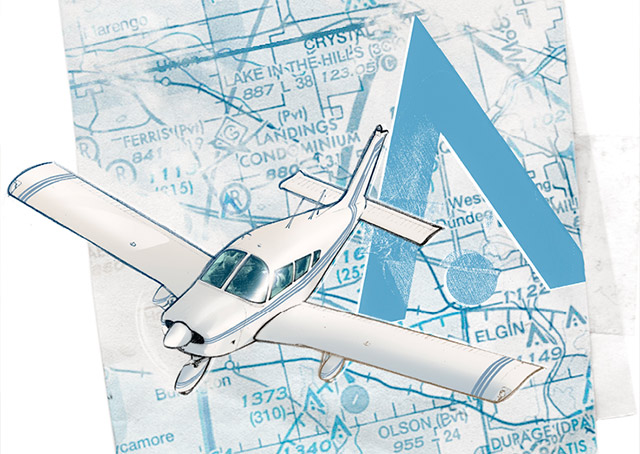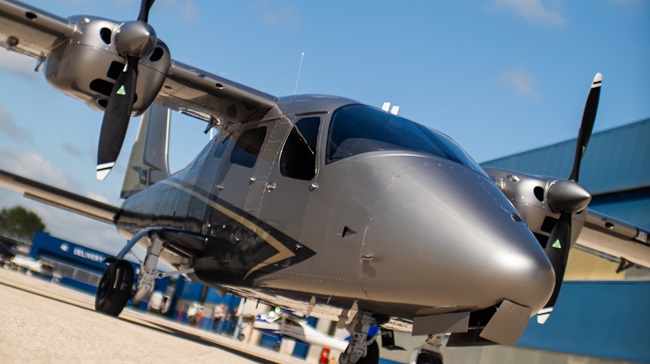The trap of an impending clearance
This wasn’t scud running, I told myself. That was something terminally stupid VFR pilots did in deteriorating weather, often ending the flight abruptly in cumulogranite.
My passenger and I were circling Landings Condominium Airport (82IS), a private, nontowered airport northwest of Chicago, in a rented Piper Cherokee 180—granted, at only 300 feet agl, with the top of the tail fin slicing the solid overcast.
But the visibility beneath the very definite ceiling was an acceptable three to five miles, marginal VFR. We met the liberal VFR weather minimums for uncontrolled airspace—one mile and clear of clouds. The July weather presented no risk of icing. I was staying close to the airport, within gliding range of the runway at all times. And below was flat, rural Illinois.
Besides, I was a newly minted, current instrument pilot. I was in constant radio contact with O’Hare Approach. Any minute now, the controller promised, he’d have my IFR clearance. We’d climb into the clag and motor confidently on instruments to Lake Geneva, Wisconsin, a mere 33 miles away.
Where was the danger?
We had stayed a couple of days at Casa de Aero, a private residential airpark seven miles west of Landings. A nearby remote antenna for O’Hare Approach afforded the airpark’s residents the luxury of picking up their IFR clearances on the ground. This day, however, we heard nothing on the frequency before takeoff.
A weak summer cold front was on the way, but the ceiling was 1,200 feet overcast as we departed Casa de Aero and, like the seven-mile visibility, it was forecast to stay that way. No problem—we’d start VFR and pick up our IFR clearance in the air.
We flew east for a few miles, and then turned north, following the road toward Lake Geneva. The Approach frequency remained silent. The solid overcast descended to 500 feet agl over the next few miles. Just to our right was Landings, where we’d landed the day before. I landed there. I refiled at Landings, and we launched again. Now we listened to Approach on a new frequency. The soup above was thick with traffic—some, like us, headed north to Oshkosh for the Experimental Aircraft Association’s huge annual fly-in.
We orbited Landings at 300 feet for a half-hour. Approach called every few minutes with the same message: “Cherokee Five-Five-Niner-Zero-Five, hang on. We’ll get to you soon. Maintain VFR.” Finally the controller suggested, “If you can get about 10 miles west, to Rockford’s airspace, they’ll be able to take you.”
“Roger,” I replied, stepping blithely into the trap. “We’ll try that.”
I headed southwest to intercept Route 90, the truck route to Rockford. I’d just keep the highway on my left, and in five minutes or so, I’d be copying my new clearance from Rockford. Piece of cake. Good thing they don’t grow mountains here, I thought.
But they grow towers.
“Henry!” I shouted, throwing the folded Chicago sectional at my dumbfounded, nonpilot passenger. “Look on the map! Find the tower!”
Henry, suddenly all elbows and thumbs, fumbled with the chart. Panicked, I grabbed it back.
There, five miles west of Landings, on the north side—our side—of Route 90, was the blue tepee. It stood 215 feet agl, 1,119 feet msl. I glanced at the altimeter: 1,100 feet.
I immediately banked left, crossing to the south side of the truck route. A mile ahead, a curtain of rain blocked our path. Our only out was a hasty retreat. I carved a steep turn 100 feet above a cornfield. The directional gyro card spun with a sickening whizzing sound.
The DG now was way off; the compass swung drunkenly in the growing turbulence. I headed northeastward, guessing at the angle across the severely rectilinear grid of farmland that would put us on course back to Landings.
Ahead, another curtain of rain materialized. It seemed so unbelievable, so unfair. This wasn’t supposed to happen. But it was happening. I eased back on the yoke, pushed the throttle to full power, and reached for the mic to declare an emergency. I would have to scatter the DC–10s and beg for forgiveness later.
Just then a beige smudge appeared ahead and slightly to the left through the curtain of rain. The hangars! I made a quick turn toward the airport and a very low, nonstandard approach to the runway. My hands were shaking as I shut down the engine. Henry seemed not to fully comprehend the peril in which I had put us.
A pilot from Cape Cod strolled over. He and his 8-year-old son were flying a Cessna 180 to Oshkosh. “How is it up there?” he smiled.
“Awful. We’re lucky to be alive.”
“Doesn’t look too bad to the north,” he ventured.
“Are you instrument-rated?” I asked.
“Nope.”
“Then there’s no way,” I declared. “We barely made it back.”
“Well, I think we’ll take a look,” he said.
They took off and immediately turned north, leveling at treetop height. The Cessna zoomed up to hop over a tree line, and then dropped out of sight, the engine’s drone fading away into the fog. I waited until we could see DC–10s overhead at 7,000 feet before we tried it again.
Later, we met up with the Cessna pilot at Lake Geneva. He and his son had been incredibly lucky.
So had we.
Jan W. Steenblik recently retired after 34 years as technical editor of Air Line Pilot. He looks forward to instructing in gliders and Light Sport aircraft, flying an Aeronca Champ, and building a Sonex in southern Indiana.
Illustration by James Carey
Digital Extra Hear this and other original “Never Again” stories as podcasts every month on iTunes and download audio files free.



